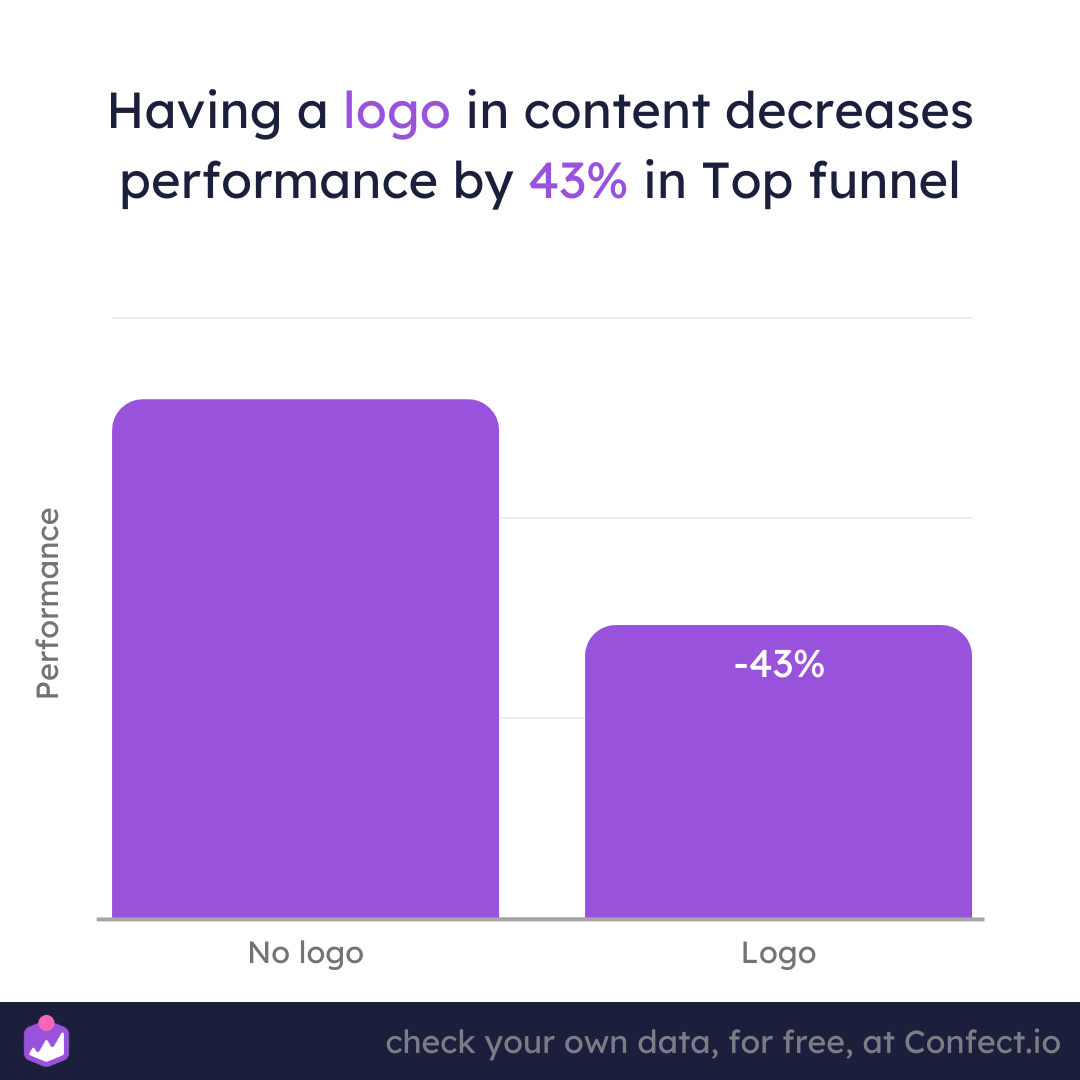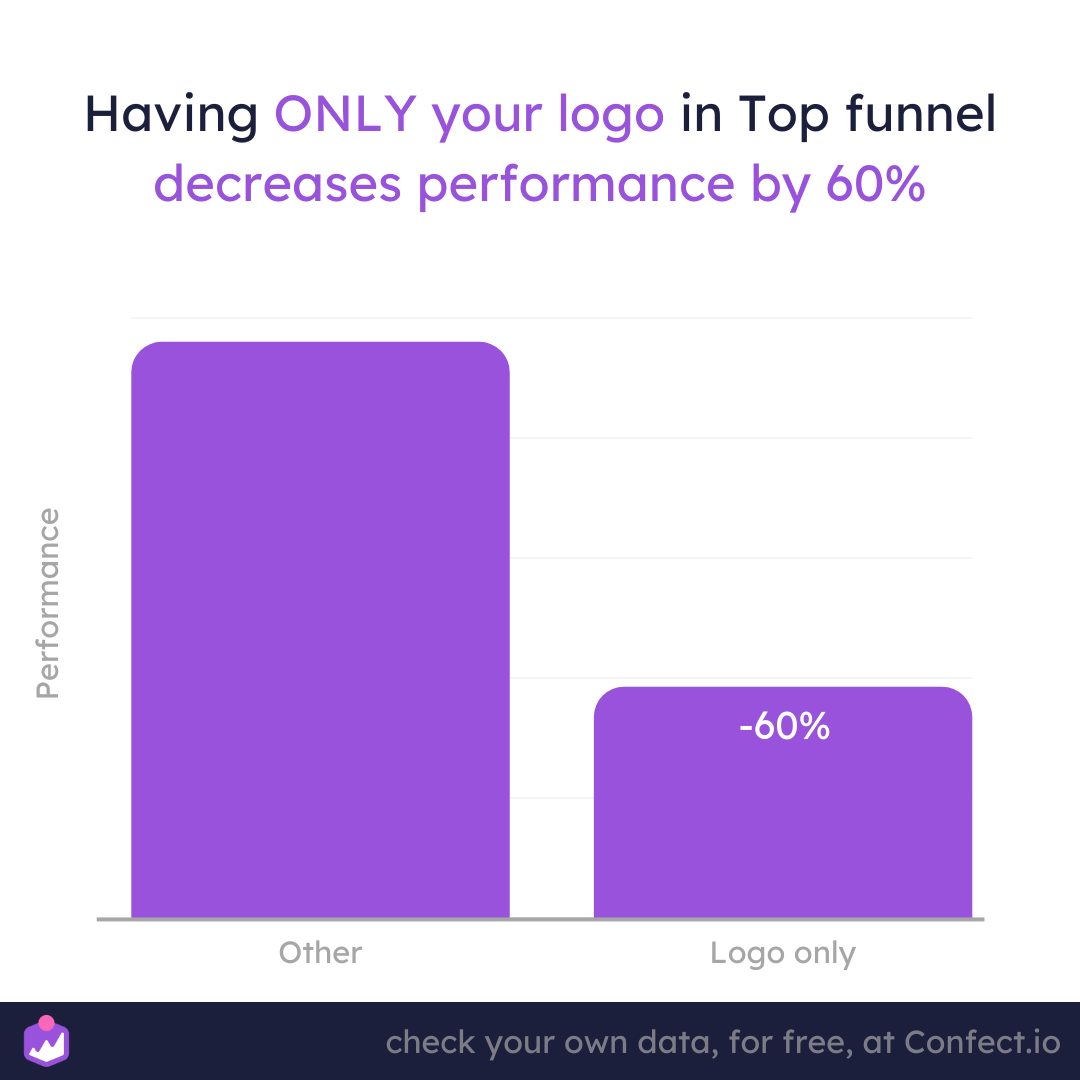Top and bottom funnel: When to use logos in the design?
October 26, 2022
In most cases, brand-minded marketers advocate for always including a logo in content to build awareness, recognition, and trust. However, data shows that, in some cases, leaving the logo out of the design may be more effective.
Factors such as the campaign's goal, particularly when looking at conversion ads, should be considered.
Also, when comparing the top and bottom funnel audiences, there is a significant difference in how a logo impacts the performance of audiences who do not know your brand (top) versus audiences who do (bottom).
Before including it in the design, you should always consider whether the target audience knows or cares about your brand and logo.
Developing a brand is a long-term investment that requires time, effort, and resources. While it may not produce immediate results, a strong brand can be a valuable asset for your business. Marketing to brand-aware audiences is often more effective because they already have an established perception of your brand.
However, it's important to consider the impact of your marketing strategies on your entire customer journey. Focusing too heavily on the top of the funnel (i.e., acquiring new customers) without considering the long-term effects on your brand recognition, trust, and awareness may ultimately harm your bottom funnel (i.e., customer retention and loyalty).
Including your brand's logo and messaging consistently can help build brand recognition and trust over time, even if it may have little impact on sales.
Let's dive a little deeper and really understand the impact of a logo in your top and bottom funnel conversion ads.
(The data reviewed in this article is based on more than 5.5 billion impressions on Meta.)
Having a logo in content decreases performance by 43% in Top funnel
Starting with the top funnel, this audience needs to learn about your brand or offer. They have likely never seen your logo and have no particular attitude toward the brand.
A logo's purpose is to represent the brand, but if the buyer does not know the brand, the logo conveys no message. It may even be distracting from the main message of the content.
In this case, adding a logo to the design can hurt performance by as much as 43%.

Read about: When is it best to use a logo in e-commerce ads?
If you're surprised by the impact that adding a logo to your content can have on performance, we have more news for you.
An even more significant drop in performance is possible if you make a particular mistake with your logo.
What mistake do you want to avoid?
Let's take a look
Having ONLY your logo in Top funnel decreases performance by 60%
Similar to what was previously discussed, top-funnel audiences do not convert better with a logo. In this case, we looked specifically at content that ONLY showed the logo, with no other text.
The decrease in performance is even more drastic, with a 60% decrease. When buyers see a logo, they recognize it and are reminded of all their experiences with the brand.
However, if the only text or element in the content is the logo, it should mean something to the audience. For audiences yet to encounter your brand, the logo conveys no message and is likely ineffective.

So we’ve explored top funnel conversion ads, and the data is apparent; a logo hurts performance in almost every instance.
So when is the best time to use your logo?
The answer might be Bottom funnel.
Bottom funnel audiences don´t mind your logo in content - almost no impact
Moving onto audiences already aware of your brand (bottom funnel), these customers have already researched and know what your brand offers. They likely know your logo and recognize what it stands for, so including it makes more sense.
However, if your content includes other text or information, the logo is not the focal point and has almost no impact on performance — see the data chart below.
In this case, it boils down to your branding decisions on whether to include a logo or not.
Since these audiences are already familiar with your brand, the logo may be optional to convey your message or entice a purchase. It may be more effective to focus on other content elements.
.png)
We know that having ONLY your logo in top funnel ads has a severe negative consequence.
Does that hold true for the bottom funnel as well?
Keep reading to find out.
Only showing logo, with no other text, performs better for Bottom funnel
As we mentioned earlier, Bottom funnel audiences are already familiar with your brand. They are knowledgeable, and seeing your logo brings back everything they know about you. To these audiences, your logo represents your values, branding, and the features of your offer.
This is why showing only your logo in the content (for example, a photo of a model overlaid with a large logo) performs 27% better.
Since these customers know what your logo and brand represent, one logo says more than one thousand words. It is a powerful reminder of your brand's value and benefits.
.png)
Looking for an easy way to add your brand's logo to your Dynamic Product Ads?
Confect provides an all-in-one solution for designing, customizing, and editing Dynamic Ads to ensure they'll stand out from your competitors!
Try a free demo of Confect today!
Let's review the key takeaways.
It is critical to realize that your logo only impacts people who recognize it.
Top funnel audiences perform worse anytime your logo is included in the content. Since they have probably never seen it, it means nothing to them and only distracts from the main message of the content.
However, bottom funnel audiences recognize your logo and know what it represents (your brand).
A logo only has a small impact if you include additional information and text in bottom funnel content. It is not what they focus on.
But if you want to run an image ad with no text, overlaying your logo could improve the performance for bottom funnel audiences.
More to read
This article focuses purely on using a logo in Top and Bottom funnel ads. Learn more with the following insights:
- Top and Bottom funnel: How does the ad body impact performance?
- What is the performance difference between Top and Bottom Funnel ads?
- Top Funnel ads: How does text in content impact performance?
- How to make Top-Funnel SALE ads that actually convert
Dataset:
The dataset from this article is based on5.5B impressions and 49.6K+ pieces of individual content on Meta (Facebook) platforms. It takes into account data from all countries and industries, with the campaign objective of conversions only. The period is from 1. September 2021 - 16. September 2022. The data is categorized based on audience type, being either Broad (Top funnel) or Custom (Bottom funnel).
Numbers are looking at correlation only, not causation. Remember to check your own data: numbers for different brands, industries, and contexts will vary.
If you were intrigued about a specific insight, you can go in-depth into the various dimensions and how data can be segmented in Confect, here.
